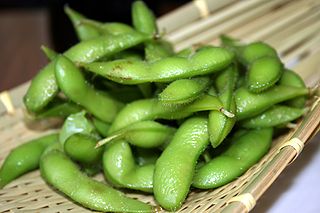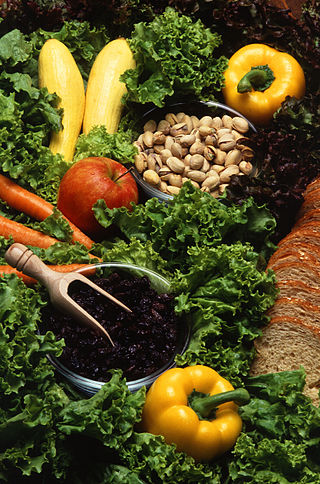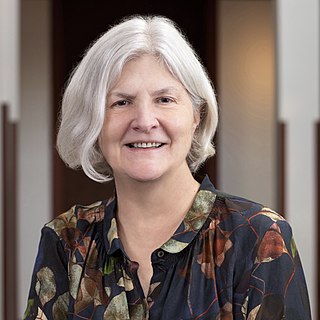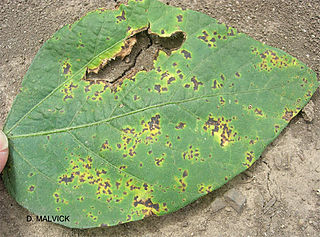Related Research Articles

The chickpea or chick pea is an annual legume of the family Fabaceae, subfamily Faboideae. Its different types are variously known as gram or Bengal gram, chhana, chana, or channa, garbanzo or garbanzo bean, or Egyptian pea. Chickpea seeds are high in protein. It is one of the earliest cultivated legumes, the oldest archaeological evidence of which was found in Syria.

The soybean, soy bean, or soya bean is a species of legume native to East Asia, widely grown for its edible bean, which has numerous uses.

Edamame is a Japanese dish prepared with immature soybeans in the pod. The pods are boiled or steamed and may be served with salt or other condiments. The dish has become popular across the world because it is rich in vitamins, dietary fiber, and isoflavones. When the beans are outside the pod, the term mukimame is also sometimes used in Japanese. Edamame are a common side dish in Japanese cuisine and as an appetizer to alcoholic beverages such as beer or shōchū. As an ingredient Edamame are found in both sweet and savory dishes such as takikomi gohan, tempura, and zunda-mochi.

Iron (Fe) deficiency is a plant disorder also known as "lime-induced chlorosis". It can be confused with manganese deficiency. Soil iron concentration is high, but can become unavailable for absorption if soil pH is higher than 6.5. Excess of elements such as manganese in the soil can interfere with plant iron uptake triggering iron deficiency.

Legumes are plants in the family Fabaceae, or the fruit or seeds of such plants. When used as a dry grain for human consumption, the seeds are also called pulses. Legumes are grown agriculturally, primarily for human consumption; for livestock forage and silage; and as soil-enhancing green manure. Well-known legumes include beans, soybeans, chickpeas, peanuts, lentils, lupins, grass peas, mesquite, carob, tamarind, alfalfa, and clover. Legumes produce a botanically unique type of fruit – a simple dry fruit that develops from a simple carpel and usually dehisces on two sides.

Plant nutrition is the study of the chemical elements and compounds necessary for plant growth and reproduction, plant metabolism and their external supply. In its absence the plant is unable to complete a normal life cycle, or that the element is part of some essential plant constituent or metabolite. This is in accordance with Justus von Liebig's law of the minimum. The total essential plant nutrients include seventeen different elements: carbon, oxygen and hydrogen which are absorbed from the air, whereas other nutrients including nitrogen are typically obtained from the soil.

Root nodules are found on the roots of plants, primarily legumes, that form a symbiosis with nitrogen-fixing bacteria. Under nitrogen-limiting conditions, capable plants form a symbiotic relationship with a host-specific strain of bacteria known as rhizobia. This process has evolved multiple times within the legumes, as well as in other species found within the Rosid clade. Legume crops include beans, peas, and soybeans.

Vegetarian nutrition is the set of health-related challenges and advantages of vegetarian diets.

In botany, chlorosis is a condition in which leaves produce insufficient chlorophyll. As chlorophyll is responsible for the green color of leaves, chlorotic leaves are pale, yellow, or yellow-white. The affected plant has little or no ability to manufacture carbohydrates through photosynthesis and may die unless the cause of its chlorophyll insufficiency is treated and this may lead to a plant disease called rusts, although some chlorotic plants, such as the albino Arabidopsis thaliana mutant ppi2, are viable if supplied with exogenous sucrose.

Serpentine soil is an uncommon soil type produced by weathered ultramafic rock such as peridotite and its metamorphic derivatives such as serpentinite. More precisely, serpentine soil contains minerals of the serpentine subgroup, especially antigorite, lizardite, and chrysotile or white asbestos, all of which are commonly found in ultramafic rocks. The term "serpentine" is commonly used to refer to both the soil type and the mineral group which forms its parent materials.
Phialophora gregata is a Deuteromycete fungus that is a plant pathogen which causes the disease commonly known as brown stem rot of soybean. P. gregata does not produce survival structures, but has the ability to overwinter as mycelium in decaying soybean residue.

Nancy C. Andrews NAS is an American biologist and physician noted for her research on iron homeostasis. Andrews was formerly Dean of the Duke University School of Medicine.

Antinutrients are natural or synthetic compounds that interfere with the absorption of nutrients. Nutrition studies focus on antinutrients commonly found in food sources and beverages. Antinutrients may take the form of drugs, chemicals that naturally occur in food sources, proteins, or overconsumption of nutrients themselves. Antinutrients may act by binding to vitamins and minerals, preventing their uptake, or inhibiting enzymes.

Phosphorus deficiency is a plant disorder associated with insufficient supply of phosphorus. Phosphorus refers here to salts of phosphates (PO43−), monohydrogen phosphate (HPO42−), and dihydrogen phosphate (H2PO4−). These anions readily interconvert, and the predominant species is determined by the pH of the solution or soil. Phosphates are required for the biosynthesis of genetic material as well as ATP, essential for life. Phosphorus deficiency can be controlled by applying sources of phosphorus such as bone meal, rock phosphate, manure, and phosphate-fertilizers.
Forest pathology is the research of both biotic and abiotic maladies affecting the health of a forest ecosystem, primarily fungal pathogens and their insect vectors. It is a subfield of forestry and plant pathology.
Volker Roemheld was a German agricultural scientist, plant physiologist and soil biologist at Hohenheim University.

Bacterial blight of soybean is a widespread disease of soybeans caused by Pseudomonas syringaepv. glycinea.
Sudden death syndrome (SDS), a disease in soybean plants, quickly spread across the southern United States in the 1970s, eventually reaching most agricultural areas of the US. SDS is caused by multiple Fusarium fungi in the Fusariumsolani complex. Fusarium virguliforme is the sole causal agent in North America. In South America, Fusarium brasiliense, F. cuneirostrum, F. tucumaniae, and F. virguliforme are all causal agents. Losses could exceed hundreds of millions of dollars in US soybean markets alone making it one of the most important diseases found in Soybeans across the US.
Anna Amtmann is a German scientist. She is professor for Molecular Plant Physiology at the University of Glasgow. She serves as Editor-in-Chief of the journal Plant, Cell & Environment.
Margaret Wyn Loutit was a New Zealand microbiologist. She was a full professor at the University of Otago from 1981, and was the inaugural director of the university's Research Office from 1988 to 1995
References
- 1 2 Communication, Centre for Science. "Centre for Science Communication Nancy Longnecker". www.otago.ac.nz.
- ↑ Longnecker, Nancy Ellen (13 August 1982). "Factors affecting iron uptake by iron-efficient and inefficient soybean varieties" – via Open WorldCat.
- ↑ Longnecker, Nancy Ellen (13 August 1986). "A comparison of the resistance of soybean and sunflower to iron-deficiency induced chlorosis" – via Open WorldCat.
- ↑ "Citizen science may boost engagement and understanding in undergraduate biology classes: Using ClimateWatch application to collect data for class promoted both research and learning".
- ↑ "University science centre expanding". 16 July 2014.
- ↑ "Opportunities grow in science communication". 15 October 2015.